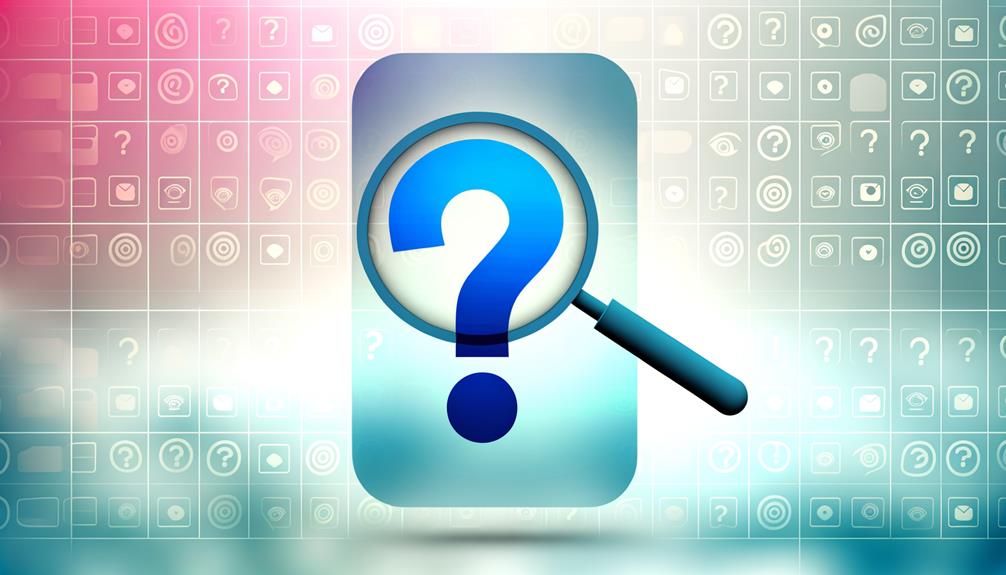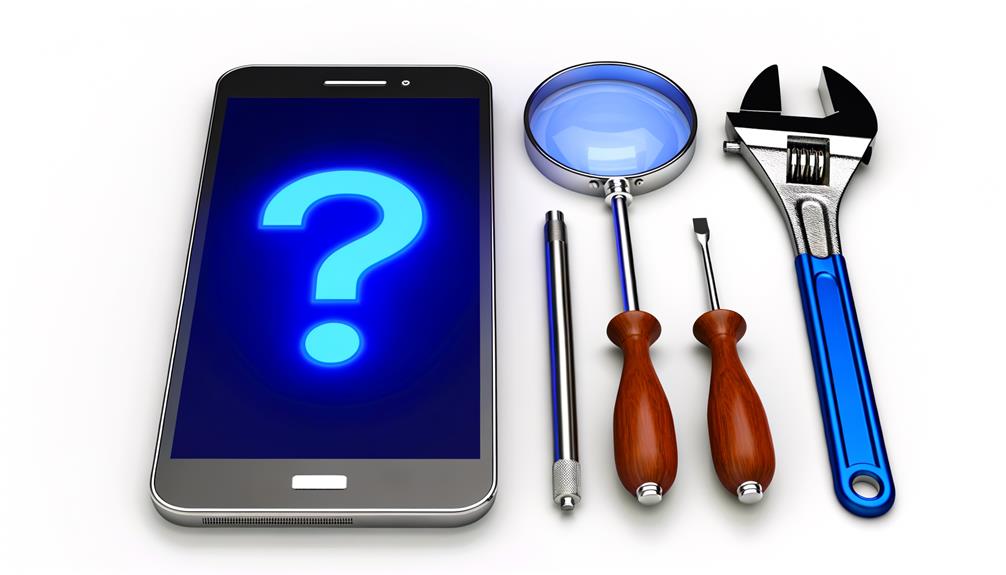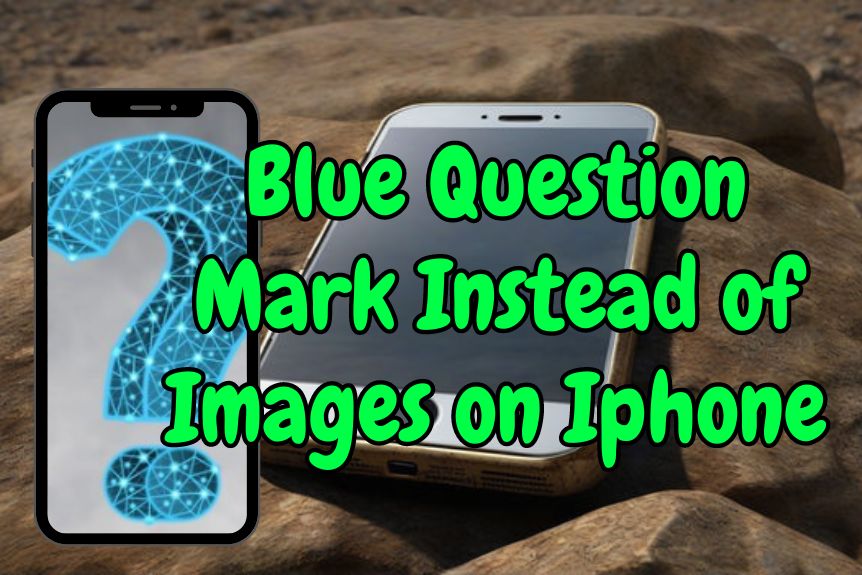When you see a blue question mark instead of images on your iPhone, it indicates an issue with image loading or display settings. The cause can vary from incorrect email settings, unsupported image formats, to network connectivity issues. A quick fix could be updating your device’s iOS version or adjusting network settings. As a last resort, resetting settings on your iPhone may clear the issue. More solutions and in-depth troubleshooting await your further exploration.
Understanding the Blue Question Mark

If you’re an Apple device user, you may have encountered a perplexing blue question mark appearing in place of images on emails or webpages, indicating a problem with locating the image file. This technical glitch, identified by the ‘blue box with question,’ is a common dilemma reported by numerous users across different Apple devices, including iPhones, iPads, and Macs.
When this issue arises in Apple Mail or other applications, it means that the system can’t find the image file which should be displayed. Instead of the intended image, a blue box with a white question mark inside is shown, which can be quite baffling if you’re not familiar with the problem.
The issue has been persistent for about a decade, with no definitive fix from Apple. This enduring problem can disrupt your browsing or email experience, making it difficult to view or share images correctly.
While it’s frustrating, there’s solace in knowing you’re not alone in this predicament. If the issue continues to interfere with your browsing or Apple Mail usage, a suggested workaround is to employ a different browser. Although not a definitive solution, it could help alleviate the problem until a more permanent fix is made available.
Causes of Image Loading Issues
While you’re pulling your hair out over the persistent blue question mark replacing your images on iPhone, it’s crucial to understand the potential causes, which could range from incorrect email settings to network connectivity issues.
- Incorrect Email Settings or Preferences: If you’re seeing blue question marks instead of images, it could be due to the Mail preferences on your device. Images may not load correctly if there’s an error in the settings, or if certain image-loading preferences are disabled.
- Compatibility Issues: The problem could also arise from compatibility issues between devices. If the sender’s device uses a different format or protocol than your iPhone, images mightn’t display correctly, appearing as blue question marks instead.
- Unsupported Image Format: Another possible cause is the image file format not being supported by the email client on your iPhone. If the format of the image sent is incompatible, the email client might display a blue question mark instead of the image.
- Network Connectivity Issues: Finally, issues with your network connection could be the culprit. Poor or unstable internet connection might hinder the proper loading of images, resulting in the appearance of question marks.
Steps to Fix Image Problems

Now that we’ve understood the potential causes of the blue question mark problem on your iPhone, let’s tackle the steps you can take to fix these image issues.
The first thing you should do is update your iPhone to the latest iOS release. This could address potential bug fixes related to image display issues that might be causing the question mark in place of images.
Next, you’ll want to check your network settings. Sometimes, changes here could be responsible for images appearing as question marks. Make sure everything is set up correctly.
The third step is to examine your privacy protection settings in the Mail app. It’s possible that these settings are preventing images from loading correctly, causing a blue question mark to appear instead. Disabling these settings should allow images to load without any extra steps.
If these steps don’t work, you should consider resetting all settings on your iPhone. This is a bit of a drastic measure, but it can potentially resolve any underlying issues that are affecting image display.
Potential Software Conflicts
You might encounter software conflicts on your iPhone due to incompatible applications or system updates, which could lead to the blue question mark issue.
It’s crucial to grasp the significance of app updates in this situation, as updating your apps and iOS can often resolve such conflicts.
If you’re still experiencing image display errors, troubleshooting recent changes on your device could be a significant step towards resolution.
Identifying Software Compatibility Issues
If your iPhone’s displaying blue question marks instead of images in emails, it’s likely you’re dealing with software compatibility issues between your email client and the iOS version. Various factors can trigger this issue.
- Different email clients may not fully support certain image file formats. If an unsupported format is opened, it may appear as a blue box with a question mark.
- Apple’s iOS and your email app might be in conflict. This can lead to the failure of image loading, resulting in the display of blue question marks.
- Third-party email apps or plugins could be the culprits. If they’re incompatible with certain image types, you’ll see those annoying blue question marks.
Recognizing these software conflicts is the first step towards solving this pesky problem.
Role of App Updates
App updates, often seen as routine enhancements, can inadvertently introduce software conflicts that manifest as blue question marks replacing images on your iPhone. This anomaly arises from changes in app code, compatibility issues, or bugs introduced in the new version. Such conflicts disrupt image-loading functionality, leading to the perplexing appearance of question marks instead of images.
To help you understand, here’s a table outlining potential conflict sources and their impact:
| Source of Conflict | Impact |
|---|---|
| Changes in App Code | Unexpected behavior like image display errors |
| Compatibility Issues | App may not work well with your iPhone’s OS |
| Bugs in Updated Version | Random errors such as blue question marks instead of images |
Monitoring the impact of app updates on image display is crucial to identify and promptly address any software conflicts.
Troubleshooting Image Display Errors
Having grasped the role of app updates in causing image display issues, let’s now explore how to troubleshoot these software conflicts that could be causing the blue question mark problem on your iPhone.
- App-Specific Conflicts: Check for any app-specific areas that might be triggering the ‘blue box with a question mark’ problem. This can include outdated apps, or apps that haven’t been optimized for the latest iOS.
- Image File Formats: Make sure that the image file formats are compatible with your email or browser. Files like .tiff or .bmp mightn’t display correctly, triggering the appearance of the blue question mark.
- Reset App Settings or Reinstall: If the problem persists, consider resetting the app settings or even reinstalling the problematic app. This could potentially resolve the software conflict causing the display error.
Importance of Regular Updates
Keeping your iPhone updated is essential for its best performance. Regular updates not only provide the most recent security patches, but also fix bugs that may lead to issues like the blue question mark instead of images.
It’s a vital step in maintaining device stability and avoiding common software conflicts.
Understanding Regular Updates
In the world of technology, regular updates to your iPhone’s operating system are a lifeline, indispensably fixing bugs, enhancing security measures, and boosting overall performance. If you’ve been seeing a blue question mark instead of images on your iPhone, it’s a clear signal that it’s time to update your device.
Here’s why:
- Every update includes bug fixes. These aim to resolve issues like the blue question mark, which can be frustrating.
- Updates also enhance security, protecting your device from new threats.
- Finally, updates boost performance, ensuring your iPhone runs smoothly.
Impact on Device Performance
While it’s clear that updates address annoying glitches like the blue question mark, they also have a big impact on your iPhone’s overall performance. Regular updates optimize system resources, improve compatibility, and enhance stability. They also fix security vulnerabilities and implement performance improvements. When you overlook updates, your device may face compatibility issues, leading to a gradual decline in performance over time.
In particular, firmware updates can greatly enhance your device’s functionality. They can resolve issues like the blue question mark replacing images, a common problem discussed in the Apple Support Communities. To maintain top performance and guarantee the smooth operation of your iPhone, it’s crucial to promptly install all updates.
Other Solutions to Try

Beyond the basic troubleshooting, you’d find it worthwhile to explore other solutions such as disabling ‘Load Remote Images’ in your Mail settings. This action can often resolve the issue of seeing a blue box with a question mark instead of images on your iPhone. The problem may be due to the email app’s security settings blocking remote images from loading automatically.
To address this, follow these steps:
- Go to ‘Settings’ on your iPhone, then ‘Mail’.
- Find the ‘Load Remote Images’ option and switch it off.
- Restart your Mail app and check if images now load correctly.
If this doesn’t work, you might consider using another email app like Gmail or Outlook, which may provide better image compatibility. Alternatively, clearing your email app’s cache and cookies could also be beneficial. This can be done within the app’s settings.
Another route is to contact the email sender or administrator for support. They may be able to provide further insight or help resolve image display problems. These are just a few potential solutions to the blue question mark issue on your iPhone.
